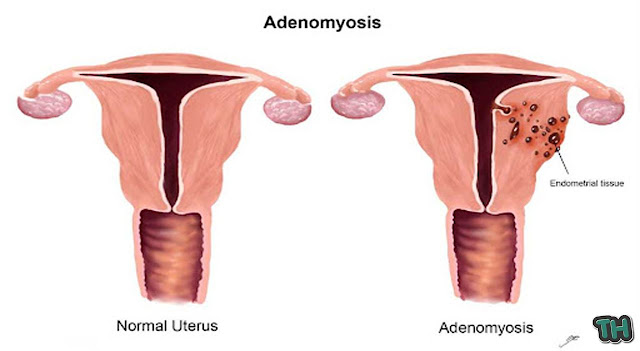Adenomyosis or adenomyosis is a condition that occurs when the surface of the uterine cavity (endometrial) grows in the wall of the uterine muscle (myometrium). Under normal conditions, the endometrial tissue should only coat the surface of the uterine cavity.
This condition can be experienced by women in all age groups, but more often occurs at the age of 40-50 years. Although generally considered not harmful, adenomyosis can affect the quality of life of sufferers.
When someone experiences adenomyosis, the endometrial network can still function normally. But due to adenomyosis, the uterus will enlarge, and cause a lot of bleeding and pain in the lower abdomen.
Symptoms of adenomyosis
Some adenomyosis sufferers do not experience any symptoms. Sometimes it can appear discomfort on the lower stomach or pelvis, but only for a moment. Whereas in other sufferers, adenomyosis can cause symptoms, namely:
- Heavy and prolonged bleeding during menstruation (Menorrhagia).
- Menstrual pain (dysmenorrhea).
- A sense of depression in the lower abdomen or pelvis, as a result of the uterus.
When to go to the doctor
Menstrual pain or dysmenorrhea is one of the symptoms caused by adenomyosis. Consult a doctor if the menstruation pain feels excessive or irresistible, there have been 3 consecutive cycles and has disrupted activity.
You are also advised to consult a doctor if bleeding during menstruation is more than usual or bleeding from the vagina after menopause.
Causes of adenomyosis
Until now, the cause of adenomyosis cannot be ascertained. But experts suspect several factors can trigger the emergence of adenomyosis, namely:
- Ever conducted an operation on the uterus, for example, Caesarean section.
- Inflammation in the uterus, for example, due to infection.
- Uterine abnormalities.
- Changes in hormone levels, for example, due to menstruation or menopause.
- Around 40 to 50 years old.
- Tamoxifen drug consumption to breast cancer.
Adenomyosis diagnosis
As a first step, the doctor needs to know the symptoms and do a physical examination of sufferers. The doctor will especially check the lower stomach or pelvis to find out whether uterine enlargement occurs and there is no pain when pressed.
Diagnosis of adenomyosis is difficult to ensure only from the symptoms that arise, because they are similar to other uterine diseases, such as myoma, endometriosis, or endometrial polyps. To ensure the diagnosis, the doctor needs to carry out additional checks in the form of:
- Pelvic ultrasound (lower abdomen) or transvaginal
Ultrasound can see the enlargement of the uterus, changes in the shape of the uterus muscle, the presence of uterine cysts, or endometrial thickening.
- MRI uterus
This examination is done by a doctor to see the condition of the uterus in more detail.
- Blood check
This examination is done to determine the impact of bleeding, namely anemia or less blood.
- Endometrium biopsy
This extraction and examination of endometrial tissue samples are carried out to ensure the occurrence of adenomyosis.
Adenomyosis treatment
Handling of adenomyosis sufferers will be adapted to the severity of symptoms, giving birth history, and the desire of sufferers in the descendants in the future.
To reduce mild pain, treatment independently can be done, by soaking in warm water or using warm pads in the stomach. Medication for free pain relief, such as paracetamol, can also be consumed to reduce pain.
If these efforts have not been able to relieve adenomyosis symptoms or there is much menstrual bleeding, consult the obstetrician to get further treatment. The obstetrician will handle with:
Painting Medication
Nonsteroidal anti-inflammatory drugs, such as mefenamic acid, can be given to reduce pain.
Hormone therapy
This therapy is given to patients who experience much bleeding during menstruation or pain that is unbearable. Examples of hormone therapy are birth control pills.
Endometrium Ablation
This procedure aims to destroy the uterine layer that has adenomyosis. Although, this procedure can only be done if adenomyosis has not entered too deep into the uterus muscle.
High Intensity Focused Ultrasound (HIFU)
In this procedure, the area that is experiencing adenomyosis will be illuminated with a special ultrasound tool to remove endometrial tissue.
Adenoidectomy
This procedure is carried out to lift the adenomyosis network through surgery. The new operating procedure is recommended if other ways do not succeed in eliminating adenomyosis.
Uterine artery embolization
This procedure is carried out to inhibit the blood flowing into the adenomyosis area, so the size will shrink and complaints subside. This procedure is carried out in sufferers who cannot undergo surgery.
Hysterectomy
Hysterectomy or removal of the uterus is carried out if the Andenomiosis cannot be overcome in other ways. This procedure is only recommended if the sufferer no longer wants to get pregnant.
Adenomyosis complications
Adenomyosis with large and prolonged bleeding when menstruation can cause anemia or less blood. In addition to anemia, adenomyosis can also interfere with the quality of life of sufferers, because the taste is uncomfortable when activity due to menstruation and many menstrual bleeding.


Post a Comment for "Adenomyosis"